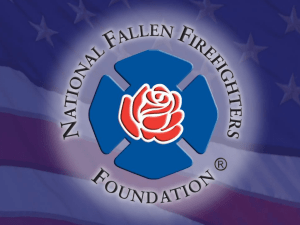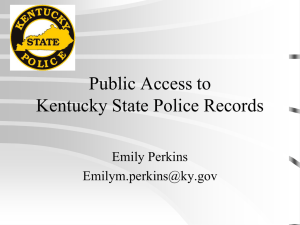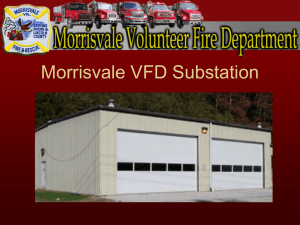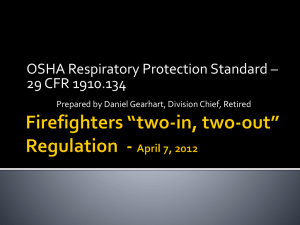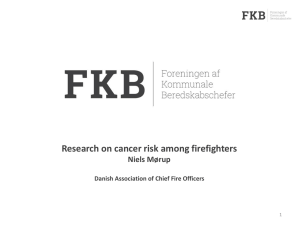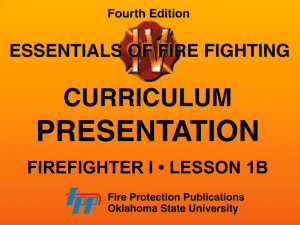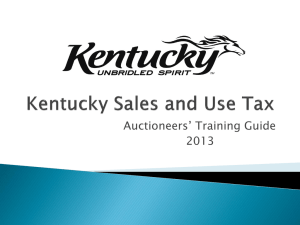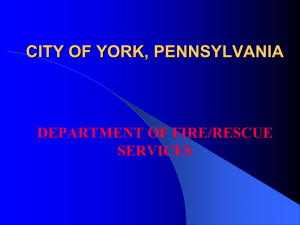HERE - Buffalo Trace Area Development District
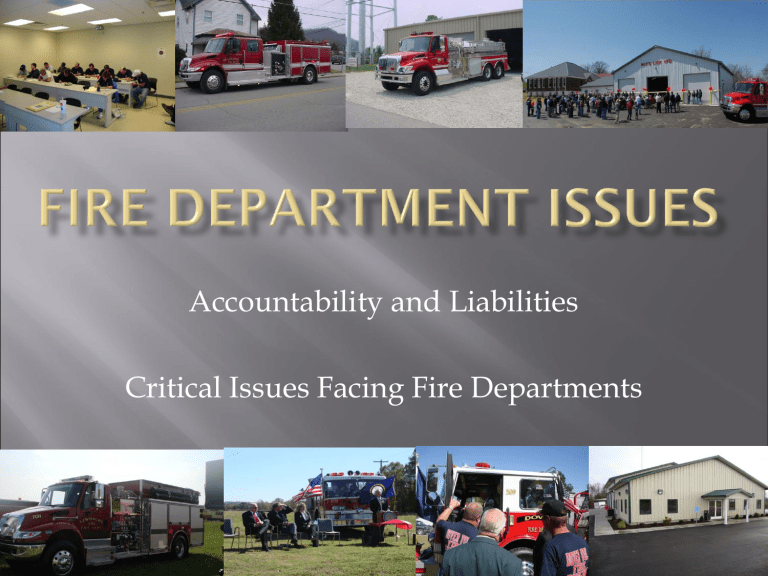
Accountability and Liabilities
Critical Issues Facing Fire Departments
Kevin Cornette, Economic Development Director
Buffalo Trace Area Development District – Focus on
Community Development and Funding for Special
Districts
Kentucky Certified Firefighter – 14 Years
Chaplain for Lewis County Firefighters Association
– Since 1997
Past President of the Buffalo Trace Firefighters
Association
My Goal is to give you an Overview of how
Fire Departments in General Work in Kentucky
Each City may be setup DIFFERENTLY –
Depending how large or small the city is.
Depending on how your city operates – determines how the funding and Management of the department is handled.
In many Case - City Fire Departments can vary from county to county – region by region.
Kentucky State Fire Commission – Provides
Oversight, Resources, Training, and Assistance
Website: http://kyfirecommission.kctcs.edu/
Fire Commission Mission in a Nutshell:
To Train Firefighters
Fire Commission is part of the KCTCS System
Provide Training to Firefighters
Regional Directors who coordinate and provide training.
Provides each department with on-site training for
CED hours each year.
Monitors and Audits Training Records of Fire
Departments.
Insures Compliance with all Standards related to Training
Provides Training Resources – Such as Smoke
Trailers, Survival Courses, etc.
Monitors Financial Reports of Fire
Departments
Disburses Fire Department State Aid annually
– current amount is $8,250.
Has a Low Interest Loan Program Available –
Up to 75,000 for 12 years – 3% interest – Payment withheld from Annual State Aid Payment
Used for Apparatus, Building, and Equipment
KRS 95 – City Police & Fire Departments
Different Laws for Different Classes of Cities
KRS 95A – Fire Protection Personnel
KRS 65 – Applies and Complements KRS 75
KRS 75 – Fire Protection Tax Districts
May affect some departments that are a “city” department – but have a tax district outside the city limits.
KRS 227 – Fire Marshal
KRS 304 – Fire Reporting
Other Laws Apply – Such as Motor Vehicles, Public
Body, Open Records, etc. apply as well
Volunteer Department
Minimum of 12 members – Plus a Chief
Must have at least 1 Operational Apparatus
OR have 1 Apparatus on order
Fewer than 50% of the firefighters are being full-time paid firefighters
Paid Fire Department
At least 50% are Paid Full Time Firefighters –
Earning at least $8,000, and working a Minimum of
2,080 hours per year.
Some Cities choose to Provide a “Per Call”
Stipend for Firefighters
Example: Firefighters are paid $25 per call.
Some Cities “Reimburse” fuel and certain expenses to volunteer firefighters.
Many cities are finding that they need to “pay” for fire runs to be sure to have adequate response.
Whatever you do – Be Sure to check with your
Auditor and follow proper reporting and IRS regulations on this issue
Fire Department Service Areas are Determined by HB 4 .
Some Cities may serve their City Boundary – but also outside the city limits as the Fire
Department Boundaries were established – especially in RURAL AREAS.
Insures that all areas of the state are served by a Fire Department.
Fire Protection Tax Districts – For areas outside of the City Limits
“No Fire Protection District shall include within its metes and bounds any territory at that time or thereafter included in any city of this Commonwealth which maintains a
“Regular Fire Department”…. KRS 75.010
The Tax District and City Service area Cannot
“overlap”
City is responsible for Fire Protection
National Fire Protection Association
Provides a set of Codes and Standards for equipment, training, apparatus, and fire personnel standards.
NFPA is the Authority on Fire, Electrical and
Building Safety Codes and Policies
NFPA sets the guidelines and specifications for equipment standard.
Example:
Why do we have to have an Apparatus Pump Tested each year?
Why do we have to have a certain safety device on a piece of equipment?
Why can’t we go to the hardware store and buy a regular ax?
Why can’t we wash the firefighters uniforms with
Tide?
Insurance Services Office – ISO
ISO is the leading guideline for property / casualty insurance risks
ISO oversees the Fire Protection Classification
Systems for Departments
Communities are given an ISO classification which determines what residents and businesses pay for Insurance Premiums
Community are classified as a 1 – 10
10 – No Fire Protection
7
6
9 –
8
5
4
3
2
1 – Best Possible Fire Protection
The lower the Classification Number – the Lower the Insurance Costs for the Community.
Example : From a Class 9 to a Class 5
Categories affecting Classification
Fire Alarms – 10% of score
Engine Companies – 50% of score
Water Supply – 40% of score
Each Class has a set of requirements for the type and amount of equipment, training, water supply that is needed to obtain that class rating
10% of Score
How well department receives fire alarms and dispatches its resources. ( Response Times)
Communications Center – 911 Center – where the call goes, who answers, how many operators at center and number of calls
Received per dispatcher
Reviews Telephone Service - # of lines to center, # of emergency listings in phone book,
# of Dispatch Circuits, and how the center notifies Firefighters
50% of Score
Overall grading is based on the number of
Engine Companies and the amount of water a community needs to fight a fire
ISO Checks that the fire department tests its pumps regularly and inventories each engine company's nozzles, hoses, breathing apparatus, and other equipment.
A minimum equipment list is provided by ISO to the Department.
ISO also reviews the following:
type and extent of training provided to fire-company personnel
number of people who participate in training firefighter response to emergencies maintenance and testing of the fire department's equipment
40% of Score
This portion focuses whether the community has sufficient water supply for fire suppression beyond daily maximum consumption
ISO surveys all components of the water supply system, including pumps, storage, and filtration.
To determine the rate of flow the water mains provide, ISO observes fire-flow tests at representative locations in the community.
ISO evaluates the distribution of fire hydrants in area.
Water System Provider is under close scrutiny during the ISO evaluation to insure that the system can provide fire protection.
Communities without Fire Hydrants, must have other means to provide the gallons of water required for maximum fire protection.
An example of other means are large tanker trucks, mutual aid from neighboring departments, etc.
To become a Certified Volunteer Firefighter, you must receive 150 hours of Training –
Classroom and hand on.
You must have 20 CED hours each year thereafter to maintain certification.
The Kentucky Fire Commission monitors each department to insure compliance with required hours.
To become a Certified Career Firefighter, you must receive 400 hours of Training – Classroom and hands on.
You must have 100 CED hours each year thereafter to maintain certification.
The Kentucky Fire Commission monitors each department to insure compliance with required hours.
Training forms can be found at http://kyfirecommission.kctcs.edu/Fire_Com mission_Programs/Training_Records
Training includes the following:
Fire Prevention and Fire Suppression
Response to Technical Rescue Incidents
Emergency Medical Services
Response to Hazardous Materials Incidents
Leadership and Management
Community Awareness and Preparation
Each Department is Required to Have Liability
Insurance.
VFIS Insurance and KACO, KLC are the only entities offering Fire Department Insurance
Must have coverage on all items, including all equipment.
Many Departments form associations to purchase insurance as a group to save costs.
Each Firefighter is protected through the
Kentucky State Fire Commission with
Workman’s Compensation. designed to compensate employees for loss of earning power due to work-related injuries or illness arising out of, and in the course of their employment.
State Aid Funds Reporting
Department Must provide a Receipt and Cancelled check for Equipment Purchased
May only be used for Approved list of Items
The Kentucky Fire Commission allots eight thousand two hundred fifty dollars ($8,250) on an annual basis to each qualifying volunteer fire department in cities of all classes.
City Funds
All expenditures from City Accounts for Fire
Department Expenses should be invoiced to city, paid by city, and audited by city auditor
Cities should keep an accounting of all fire department funds;
Income and expenses
Annual Balance Sheet – ( Fire Commission has an annual form they have department complete found at
Keep an inventory of all equipment
Insure that everything is insured
Maintain copies of all equipment and pump tests.
Each Department should be keeping and submitting the following:
Record of Each Training
Data entry of training hours into Fire Commission
System for each member
Hard Copies of all training records on file at the department.
Proof of Purchase – State Aid Reimbursements
Financial Statements
Approved Purchase List
Found at http://kyfirecommission.kctcs.edu/Fire_Commissio n_Programs/State_Aid
City Fire Departments – Income and Expenses flowing through City budget should be audited as part of the City Audit
KRS 75.255 states: With Respect to audits and financial reports, the board of trustees of fire protection districts and volunteer fire department districts shall follow the procedures of KRS 65.065
Annual Expenses less than $750,000 – shall prepare annual statement and every 4 years complete an audit
Annual expenses greater than $750,000 shall have an annual audit completed.
MONEY! – Always an Issue.
FINDING VOLUNTEERS
Demands of Training Hours
Mutual Aid Agreements a MUST!
MEETING NFPA GUIDELINES
ISO RATINGS – Keeping up with
Requirements
Money – Low Interest Loans and Grants
Low Interest Loans
Fire Commission Program
USDA Community Facilities
Area Development RLF Programs
KLC Loan and Lease Programs
Grants
USDA Community Facilities
FEMA Fire Act Grants
Community Development Block Grants ( CDBG)
Kentucky Office of Homeland Security



